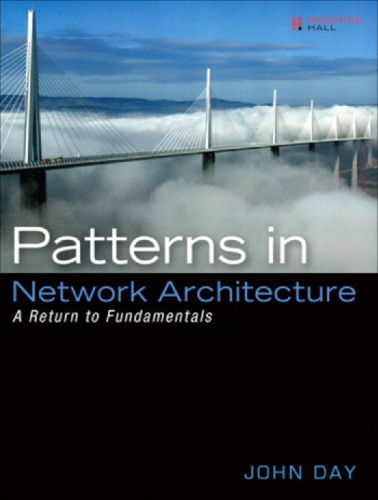Product desciption
Patterns Of Protocols Rethinking Network Architecture Day John by Day, John 9780132252423, 9782007040173, 9783920070049, 0132252422, 2007040174, 3920070046 instant download after payment.
Groundbreaking Patterns for Building Simpler, More Powerful NetworksIn Patterns in Network Architecture, pioneer John Day takes a unique approach to solving the problem of network architecture. Piercing the fog of history, he bridges the gap between our experience from the original ARPANET and today’s Internet to a new perspective on networking. Along the way, he shows how socioeconomic forces derailed progress and led to the current crisis.Beginning with the seven fundamental, and still unanswered, questions identified during the ARPANET’s development, Patterns in Network Architecture returns to bedrock and traces our experience both good and bad. Along the way, he uncovers overlooked patterns in protocols that simplify design and implementation and resolves the classic conflict between connection and connectionless while retaining the best of both. He finds deep new insights into the core challenges of naming and addressing, along with results from upper-layer architecture. All of this in Day’s deft hands comes together in a tour de force of elegance and simplicity with the annoying turn of events that the answer has been staring us in the face: Operating systems tell us even more about networking than we thought. The result is, in essence, the first “unified theory of networking,” and leads to a simpler, more powerful—and above all—more scalable network infrastructure. The book then lays the groundwork for how to exploit the result in the design, development, and management as we move beyond the limitations of the Internet.Using this new model, Day shows how many complex mechanisms in the Internet today (multihoming, mobility, and multicast) are, with this collapse in complexity, now simply a consequence of the structure. The problems of router table growth of such concern today disappear. The inescapable conclusion is that the Internet is an unfinished demo, more in the tradition of DOS than Unix, that has been living on Moore’s Law and 30 years of band-aids. It is long past time to get networking back on track.• Patterns in network protocols that synthesize “contradictory” approaches and simplify design and implementation• “Deriving” that networking is interprocess communication (IPC) yielding• A distributed IPC model that repeats with different scope and range of operation• Making network addresses topological makes routing purely a local matter• That in fact, private addresses are the norm—not the exception—with the consequence that the global public addresses required today are unnecessary• That mobility is dynamic multihoming and unicast is a subset of multicast, but multicast devolves into unicast and facilitates mobility• That the Internet today is more like DOS, but what we need should be more like Unix• For networking researchers, architects, designers, engineersProvocative, elegant, and profound, Patterns in Network Architecture transforms the way you envision, architect, and implement networks.Preface: The Seven Unanswered Questions xiiiChapter 1: Foundations for Network Architecture 1Chapter 2: Protocol Elements 23Chapter 3: Patterns in Protocols 57Chapter 4: Stalking the Upper-Layer Architecture 97Chapter 5: Naming and Addressing 141Chapter 6: Divining Layers 185Chapter 7: The Network IPC Model 235Chapter 8: Making Addresses Topological 283Chapter 9: Multihoming, Multicast, and Mobility 317Chapter 10: Backing Out of a Blind Alley 351Appendix A: Outline for Gedanken Experiment on Separating Mechanism and Policy 385Bibliography 389Index 399


